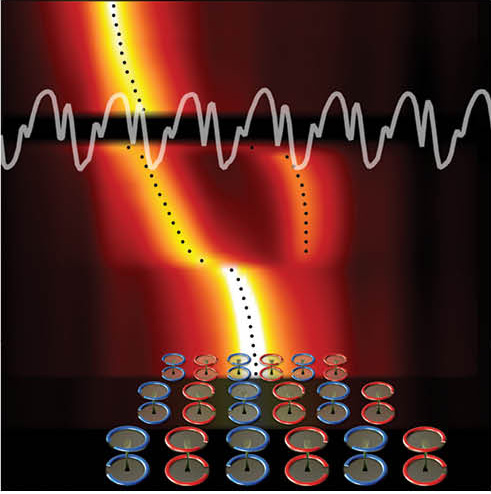 Interplay between electromagnetic and elastic coupling triggers spontaneous symmetry breaking in metamaterials. Power-dependent transmission spectra and the time evolution of self-oscillation are observed in coupled pairs of chiral split-ring resonators.
Interplay between electromagnetic and elastic coupling triggers spontaneous symmetry breaking in metamaterials. Power-dependent transmission spectra and the time evolution of self-oscillation are observed in coupled pairs of chiral split-ring resonators.
The advent of metamaterials provides novel ways to control light-matter interaction. Proper design and fabrication of the metamaterial units—“meta-atoms” and “meta-molecules”—have realized exotic properties unavailable with natural materials. These studies have inspired unconventional ideas in optics and photonics, and the promise of various ultracompact, highly efficient meta-devices.1 One important current direction is achieving dynamic control over the exotic properties of such devices, by including nonlinear or tunable elements into passive metamaterials. Alternatively, one can design meta-molecules with deformable structures; for example, mechanical tuning is now widely used in THz metamaterials.
Structural tuning offers the advantages of modulation contrast and the ability to manipulate meta-molecules individually. However, deformation based on static electrical or magnetic forces is not straightforward for optical metamaterials with sub-micrometer features. To solve this problem, our research team has introduced the concept of magnetoelastic metamaterials, in which meta-molecules can be deformed by the resonantly enhanced electromagnetic (EM) force.2 One important feature of this work is that it offers a scalable, true “light controls light” solution over a wide frequency range. And the interaction between EM resonance and structural dynamics can provide rich, novel effects beyond simple modulation.
To achieve strong EM-elastic interaction, we introduced an optimized design by exploiting the torsional deformation of chiral meta-molecules. We demonstrated a giant bistable effect and dynamic nonlinear optical activity due to self-oscillation.3,4 An important recent breakthrough has been the prediction and observation of a spontaneous breaking of chiral symmetry in a metamaterial composed of enantiomeric torsional meta-molecules—that is, chiral meta-molecules with opposite handedness.5
In such a scenario, the initial configuration of the system is achiral, due to chiral symmetry. However, because of intermolecular EM interaction, the system stability changes, and such symmetry can be broken spontaneously when the incident power exceeds a certain threshold value—which in turn leads to nonlinear polarization change and mode splitting. The predicted effect is an artificial achiral-chiral phase transition, and it has been successfully demonstrated in the microwave domain. The single resonance under the configuration of chiral symmetry splits into two new resonances in the power regime of broken symmetry.
Our studies provide a novel paradigm to achieve artificial nonlinear and phase transition effects in metamaterials, via EM-elastic coupling. The realization of these effects at infrared and optical frequencies holds the potential to greatly enrich the functionality of future meta-devices.
Researchers
Mingkai Liu, David Powell, Ilya Shadrivov and Yuri Kivshar, Australian National University, Canberra, Australia
Mikhail Lapine, University of Sydney, Australia
References
1. N.I. Zheludev and Y.S. Kivshar. Nat. Mater. 11, 917 (2012).
2. M. Lapine et al. Nat. Mater. 11, 30 (2012).
3. M. Liu et al. Phys. Rev. B 87, 235126 (2013).
4. M. Liu et al. New J. Phys. 15, 073036 (2013).
5. M. Liu et al. Nat. Comm. 5, 4441 (2014).
